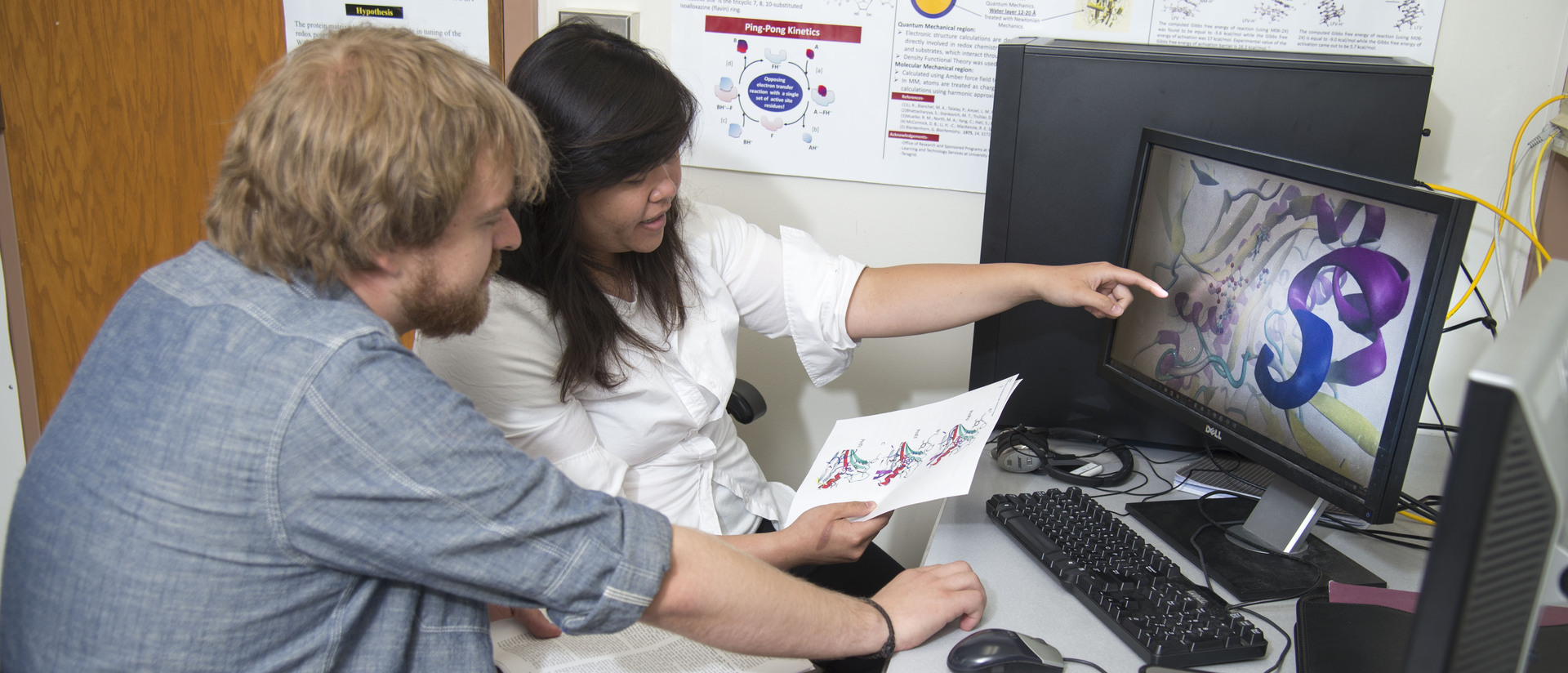
Publications
Supercomputing Research at UW-Eau Claire
UWEC has maintained its commitment to high-impact learning practices with an emphasis on undergraduate research. Students (highlighted) and their mentor collaborators are continuously exploring newer problems, studying together, and publishing their findings.
To see how supercomputing has continuously pushed forward research, check out all of the following publications since 2012 that have used our campus resources:
2025
-
Exploring Feature Selection with Deep Learning for Kidney Tissue Microarray Classification Using Infrared Spectral Imaging
Caterer, Z., Langlois, J., McKeown, C., Hady, M., Stumo, S., Setty, S., Walsh, M., & Gomes, R. (2025). Exploring Feature Selection with Deep Learning for Kidney Tissue Microarray Classification Using Infrared Spectral Imaging. Bioengineering, 12(4), 366. https://doi.org/10.3390/bioengineering12040366
2024
-
High-performance computing in undergraduate education at primarily undergraduate institutions in Wisconsin: Progress, challenges, and opportunities
Hebert, J., Hratisch, R., Gomes, R., Kunkel, W., Marshall, D., Ghosh, A., Doss, I., Ma, Y., Stedman, D., Stinson, B., Varghese, A., Mohr, M., Rozario, P., & Bhattacharyya, S. (2024). High-performance computing in undergraduate education at primarily undergraduate institutions in Wisconsin: Progress, challenges, and opportunities. In Education and Information Technologies. Springer Science and Business Media LLC. https://doi.org/10.1007/s10639-024-12582-6
2023
-
Ab Initio Molecular Dynamics Simulations of Amorphous Metal Sulfides as Cathode Materials for Lithium–Sulfur Batteries
Si, J., & Ma, Y. (2023). Ab Initio Molecular Dynamics Simulations of Amorphous Metal Sulfides as Cathode Materials for Lithium–Sulfur Batteries. In The Journal of Physical Chemistry C (Vol. 127, Issue 49, pp. 23541–23550). American Chemical Society (ACS). https://doi.org/10.1021/acs.jpcc.3c04835
-
Inter-institutional Resource Sharing in Undergraduate HPC Education: Interviews with University Administrators
Ghosh, A., Kunkel, W., Varghese, A., Ma, Y., Gomes, R., Bhattacharyya, S., Mohr, M., Doss, I., & Hebert, J. (2023). Inter-institutional Resource Sharing in Undergraduate HPC Education. In Proceedings of the 54th ACM Technical Symposium on Computer Science Education V. 1 (pp. 848–853). SIGCSE 2023: The 54th ACM Technical Symposium on Computer Science Education. ACM. https://doi.org/10.1145/3545945.3569784
2022
-
Advances in Rechargeable Lithium–Sulfur Batteries
Ma Y. (2022) Computation and Simulation. In: Manthiram A., Fu Y. (eds) Advances in Rechargeable Lithium–Sulfur Batteries. Modern Aspects of Electrochemistry, vol 59. Springer, Cham. https://doi.org/10.1007/978-3-030-90899-7_10
2018
-
Computer Simulation of Cathode Materials for Lithium Ion and Lithium Batteries: A Review
Ma, Y. (2018). Computer Simulation of Cathode Materials for Lithium Ion and Lithium Batteries: A Review. In ENERGY & ENVIRONMENTAL MATERIALS (Vol. 1, Issue 3, pp. 148–173). Wiley. https://doi.org/10.1002/eem2.12017
-
Lithiation and Delithiation Processes in Lithium–Sulfur Batteries from Ab Initio Molecular Dynamics Simulations
Arneson, C.; Wawrzyniakowski, Z. D.; Postlewaite, J. T.; Ma, Y., Lithiation and Delithiation Processes in Lithium–Sulfur Batteries from Ab Initio Molecular Dynamics Simulations. J. Phys. Chem. C 2018, 122, 8769-8779. (DOI:10.1021/acs.jpcc.8b00478).
-
Mixture is better: enhanced electrochemical performance of phenyl selenosulfide in rechargeable lithium batteries
Guo, W.; Bhargav, A.; Ackerson, J. D.; Cui, Y.; Ma, Y.; Fu, Y., Mixture Is Better: Enhanced Electrochemical Performance of Phenyl Selenosulfide in Rechargeable Lithium Batteries. Chemical Communications 2018, 54, 8873-8876. (DOI: 10.1039/c8cc04076a).
-
Phenyl Selenosulfides as Cathode Materials for Rechargeable Lithium Batteries
Cui, Y., Ackerson, J. D., Ma, Y., Bhargav, A., Karty, J. A., Guo, W., Zhu, L., & Fu, Y. (2018). Phenyl Selenosulfides as Cathode Materials for Rechargeable Lithium Batteries. In Advanced Functional Materials (Vol. 28, Issue 31). Wiley. https://doi.org/10.1002/adfm.201801791
-
Revisiting Conversion Reaction Mechanisms in Lithium Batteries: Lithiation-Driven Topotactic Transformation in FeF2
Karki, K., Wu, L., Ma, Y., Armstrong, M. J., Holmes, J. D., Garofalini, S. H., Zhu, Y., Stach, E. A., & Wang, F. (2018). Revisiting Conversion Reaction Mechanisms in Lithium Batteries: Lithiation-Driven Topotactic Transformation in FeF2. In Journal of the American Chemical Society (Vol. 140, Issue 51, pp. 17915–17922). American Chemical Society (ACS). https://doi.org/10.1021/jacs.8b07740
2017
-
Bis(aryl) Tetrasulfides as Cathode Materials for Rechargeable Lithium Batteries
Guo, W., Wawrzyniakowski, Z. D., Cerda, M. M., Bhargav, A., Pluth, M. D., Ma, Y., & Fu, Y. (2017). Bis(aryl) Tetrasulfides as Cathode Materials for Rechargeable Lithium Batteries. In Chemistry – A European Journal (Vol. 23, Issue 67, pp. 16941–16947). Wiley. https://doi.org/10.1002/chem.201703895
-
The unique chemistry of thiuram polysulfides enables energy dense lithium batteries
Bhargav, A., Ma, Y., Shashikala, K., Cui, Y., Losovyj, Y., & Fu, Y. (2017). The unique chemistry of thiuram polysulfides enables energy dense lithium batteries. In Journal of Materials Chemistry A (Vol. 5, Issue 47, pp. 25005–25013). Royal Society of Chemistry (RSC). https://doi.org/10.1039/c7ta07460c
2016
-
Highly Reversible Diphenyl Trisulfide Catholyte for Rechargeable Lithium Batteries
Wu, M., Bhargav, A., Cui, Y., Siegel, A., Agarwal, M., Ma, Y., & Fu, Y. (2016). Highly Reversible Diphenyl Trisulfide Catholyte for Rechargeable Lithium Batteries. In ACS Energy Letters (Vol. 1, Issue 6, pp. 1221–1226). American Chemical Society (ACS). https://doi.org/10.1021/acsenergylett.6b00533
-
Organotrisulfide: A High Capacity Cathode Material for Rechargeable Lithium Batteries
Wu, M., Cui, Y., Bhargav, A., Losovyj, Y., Siegel, A., Agarwal, M., Ma, Y., & Fu, Y. (2016). Organotrisulfide: A High Capacity Cathode Material for Rechargeable Lithium Batteries. In Angewandte Chemie International Edition (Vol. 55, Issue 34, pp. 10027–10031). Wiley. https://doi.org/10.1002/anie.201603897